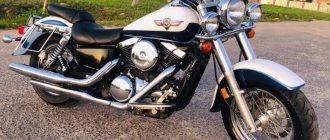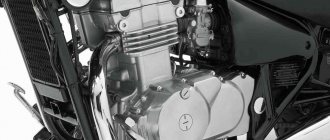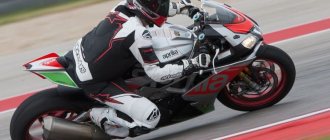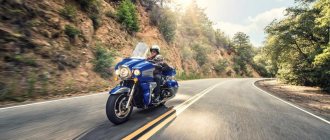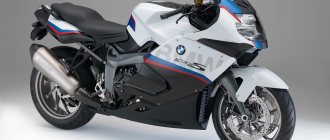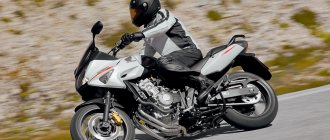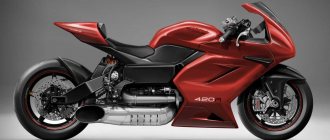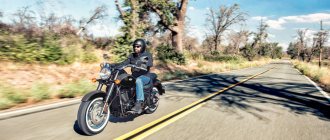Japanese motorcyclesKawasaki motorcycles
The Japanese company Kawasaki, since its creation in 1896, has been positioned as a shipbuilding company. Over time, the range of its products expanded significantly, and the company itself turned into a concern.
Now this concern is engaged in the production of industrial robots, agricultural machinery, and aviation products.
In general, the concern does a lot of things. But for us this brand is primarily associated with motorcycles.
The first attempts to create motorcycles from this manufacturer were not very successful, but the company did not give up trying to create an excellent bike.
The result was the appearance of a motorcycle that became legendary, and subsequently the flagship of the Kawasaki division that produces bikes. And this motorcycle was a Kawasaki Vulcan.
Appearance description
The first Kawasaki Vulcan appeared in 1984. It was a motorcycle made in the American classic style, because it was primarily designed for this consumer market.
Now motorcycles made in this style are designated as the “cruiser” class, i.e. designed for comfortable movement over long distances.
The first Vulcan was equipped with a power plant with a displacement of 700 cubic meters. see, although the full designation of the motorcycle was Kawasaki Vulcan 750.
Subsequently, these bikes were and are being produced with different engines, but the concept of the motorcycle itself remains unchanged .
This is a motorcycle with a low riding position and also a low center of gravity, which makes the not-so-light bike easier to handle.
Massive wide wheels, covered with equally massive fenders, add solidity to the appearance.
The wide driver's seat provides a comfortable seating position.
Adding solidity to the overall picture is the teardrop-shaped tank with a speedometer located on it, a large amount of chrome plating on the motorcycle elements and thick chrome exhaust pipes with signature cuts at the ends.
Box
The box was a very pleasant surprise. The gears are engaged softly and accurately, with the same “oil-lubricated clatter” and the same feeling. No jerking when shifting up or down. I was even surprised. It's just a real pleasure to switch. Compared to the “unbroken” custom Yamaha (apparently, the issue is rather a matter of cubic capacity) it’s simply silky.
In general, the box is configured in such a way that you need to switch (close enough to each other). On a Yamaha you could ride in second or third, but here you can use all gears. At 80 km/h you can safely drive in 4th gear. You can switch with both your toe and heel. In principle, not a problem, but in order to switch with the heel I had to move my foot “backwards”; nevertheless, switching with the toe in this regard is much more convenient (without unnecessary body movements). As a result, for the most part, I switched with my toe out of habit, but I can imagine that sometimes it’s convenient with my heel if I’m not in a hurry :).
Features of different models
But this is the general concept of the motorcycle, and the company produces these motorcycles in different versions .
For example, the Kawasaki Vulcan model with the Classic designation is a no-frills motorcycle.
But the Nomad version is equipped with glass in front, side racks on the rear fender and a supportive backrest for the passenger.
The Custom version replaces the glass with a wide fairing and lacks a supportive backrest.
Voyager is equipped with a massive fairing with glass, side racks and a backrest.
There is also an additional storage box located on top of the rear fender behind the backrest.
Motocross is a rather dangerous sport, so you should not skimp on equipment. A motorized turtle, which is reviewed in our article, can provide reliable protection for your body.
A high-quality motorcycle helmet can save the life of a motorcyclist. And in order to choose it correctly, you need to have some knowledge, which you will find here.
Modifications
During the production of the motorcycle there were three modifications.
- Kawasaki Vulcan VN400 A and Kawasaki Vulcan 400 V. Production of the model began with them. They existed on the assembly line for three years. 1995-1998. The first model had a belt drive, the second - a chain. A limited batch of the first ones was sent to America - but were not successful. The second model was officially supposed to remain only in Japan and in domestic markets was also designated as Vulcan II. The main difference between both versions is the Harley-Davidson Softail style design.
- Kawasaki Vulcan VN400 C (Classic) . Production began in 1996 . I got the same wheels 16/16 versus 21/18 for the first versions. Extended wings, like a road worker’s + a small mudguard. Black color (except for engine covers and exhaust pipes.). Produced until 2003. This and the next model already have a 14 liter tank.
- Kawasaki Vulcan VN400 D (Drifter). While the first versions borrowed design from Harley-Davidson, this one takes advantage of the developments Indian (not to be confused with the country of the same name - Indian Motocycle Manufacturing Company is located in the USA). Recessed fenders now cover the sides of the wheels, two muffler banks have been combined into one, and the saddle has been changed. Started in 1999, was released before production was completed.
Vulcan VN400 Drifter is an Indian-style version of the motorcycle.
It is worth noting that neither the letters in the name, nor the more odious name of the third model, carried any hidden meaning.
Competitors
The model turned out to be so unusual that representatives of other American brands could not imagine an equivalent one. However, not wanting to give the entire pie (market) to Kawasaki, they offered a couple of analogues at once.
Honda
Honda Steed 400 is a light cruiser designed for American needs.
Honda offered its developments Honda Steed 400 and Honda Shadow 400.
- The first featured three valves per cylinder.
- Two carburetors.
- A tank of 10 liters , with a flow rate of 5 liters .
- Production started in 1988 .
- Closed in 2001.
In addition to the above, individual modifications of the second version (Shadow) could boast an injector and a driveshaft. Fuel consumption was comparable to the first model.
The model started in 1997 and ended in 2016 .
Yamaha
Yamaha XV400 Virago - a cruiser intended for the domestic market.
Yamaha's answer was the Yamaha XV400 Virago and Yamaha XVS400 Drag Star.
Interestingly, according to the developer documentation, the second is the successor to the first. Both bikes differed from the Kawasaki by being air-cooled and having a pair of (2) valves per cylinder. Both had a driveshaft, the rear shock absorber was also different. Virago had a pair of springs (versus one), the star had a rear progression. The gas tank of the first was 13 (consumption 6) liters, the second - 15 liters (consumption 3) liters. The first started in 1987 , closed in 1994 , the second opened in 1996, existed until 2022.
Suzuki
Suzuki Intruder VS400 is a rather rare representative of serial choppers.
Suzuki did not lag behind either. For the first version he proposed the Suzuki Intruder VS400 , and for the rest the Suzuki Intruder VL400 Classic.
- The VS400 boasted a driveshaft, a carburetor hub, and a pair of springs on the rear shock absorber. 12 liter tank and consumed 4 liters . The production opened in 1994 and closed in 1996.
- The VL400 also received a driveshaft. The second generation versions were equipped with an injector. The tank is 17 liters , with a consumption of 3 liters . It is the successor to the previous model. Opened in 2001, closed in 2016.
Design
Along with the classic style, the Vulcan motorcycle series also has a classic layout. All units are attached to the frame.
The frame design is duplex, made of high-strength steel. At the front, the suspension is presented in the form of a telescopic fork.
At the rear, a pendulum suspension with two shock absorbers is used. This suspension is adjustable.
The first motorcycles used a drum brake system on the rear wheel, while a disc brake system was used on the front wheel. Later, the rear drum brakes were replaced with disc ones.
Sleeping volcano
There are not many requirements for the engine of a mid-sized cruiser, and the Kawasaki 903 cc V-twin easily “covers” them all: there is “even” power and torque delivery, and a nice design of the power plant itself, and a moderate level of vibrations, and even some high technologies that you rarely see on a V-shaped “two” device of this class.
For example, like the engines of road sports models, the VN900 Classic engine is equipped with the proprietary Kawasaki Dual Throttle Valves system, the essence of which is the use of two throttle valves in the intake channels: the first is connected by a regular cable to the throttle handle, the second, with a smaller diameter, is controlled servo drive. Due to the Dual Throttle Valves technology, the most accurate dosing of the fuel-air mixture occurs and, as a result, smoother engine reactions to the opening of the gas, as well as reduced fuel consumption.
In addition, closer to the cylinders, the intake ports become narrower, which increases the flow rate of the mixture and improves engine efficiency. Like most V-twin Japanese cruisers in the “up to 1000 cm3” category, the Kawasaki VN900 Classic engine is equipped with a liquid cooling system, although outwardly it carefully disguises itself as an honest “air blower”.
If you ignore the age-old debate about what is better for a cruiser - air or liquid cooling, which has long passed into the irrational sphere of “holy war”, then for urban use the VN900 Classic engine is a little more convenient than orthodox American power plants. Or rather, not “more convenient”, but more comfortable - and even in the abnormal heat for Moscow of 30 ° C, in which I was lucky enough to test the Kawasaki cruiser in all the capital’s traffic jams, I did not experience much discomfort due to the hot V-twin.
However, you should not be under any illusions: you won’t get much coolness from the VN900 Classic engine either, and when the cooling system fan turns on (and when driving slowly it doesn’t stop at all...), it’s not cool air from the mountain peaks that blows into your feet...
From this position, I was once again convinced: a large V-twin engine is not the best power plant option for a city motorcycle. The Kawasaki VN900 Classic engine lacks character, which is typical for mid-level cruiser powerplants. Good torque at low and mid-range speeds, sluggish performance at high speeds and modest fuel consumption of 6.5 liters per 100 km - the 903 cc V-twin is quite enough for sedate driving.
But at a slightly more “agile” pace, of course, situations arise when you regret not driving the VN1700 - for example, if you need to quickly accelerate to change lanes in traffic, and the 48-horsepower engine of the VN900 Classic reacts rather sluggishly to the movement of the handle “ gas."
But this is by no means a drawback of the motorcycle, but a typical feature of all cruisers with a similar engine size - as is the absence of a sixth gearbox! I don’t know what motivated the Japanese engineers, but even at 120 km/h I really want to switch to a higher gear, which for some reason is not in the transmission. The gearbox itself works great: the shifts are clear, the shift of the gearbox foot is moderate, and the gear lever, traditionally for cruisers, is double-shouldered, which makes it possible to press it with your heel - this is important if you are a fan of a brutal style and drive in large shoes.
I liked the proprietary “neutral” search system: when the motorcycle is in first gear, you just need to pull the gearshift lever up, and instead of switching to the second stage of the transmission, neutral will be activated. The VN900 Classic has a class-record wide rear wheel measuring 180/70–15, while competitive models from other Japanese manufacturers have a more modest 170 mm wide rear tire.
To maintain good maneuverability of the motorcycle, Kawasaki engineers made a number of tricks: for example, the angle of the VN900 Classic fork is a relatively modest 32° by cruiser standards, plus the center of gravity was as low as possible and the most “urban” weight distribution along the axles was selected, due to which The device really “steers” perfectly at any speed!
This is especially felt in tight corridors formed by cars stuck in traffic jams, where the massive and wide Kawasaki cruiser, although it does not flutter like a mini-moto, behaves very obediently and does not strive to fall into another Lamborghini or Porsche frozen in traffic...
The motorcycle suspension did not leave any vivid memories in my memory. Which, however, is also not bad: even when the VN900 Classic was loaded with a passenger, the device did not turn into a popsicle “floating” in the sun, although the swing of the chassis became much more noticeable. To perform the tasks that cruisers of this class regularly face, the potential of the fork and monoshock of the 900 Vulcan is quite sufficient. Overall, the Kawasaki VN900 Classic is a fairly smooth model, well balanced and self-sufficient.
The only thing that slightly spoils the impression of the device are the very sluggish brakes: two 2-piston calipers are called upon to stop the 282-kilogram car - one at the front and one at the rear, respectively. I understand that discussing the effectiveness of a cruiser's braking system is something of a taboo, but in the case of the VN900 Classic, the situation is really bad.
Of course, I succeeded in making the difficult vehicle quickly slow down, but it required titanic efforts applied to the front and rear brake levers! And considering that there is no feedback in principle (like ABS too...), blocking the wheel is a very real prospect. Especially if a newbie gets behind the wheel of the VN900 Classic.
Power plants by year of motorcycle production
But the range of power plants installed on this motorcycle is quite extensive.
The first Kawasaki Vulcan, as already mentioned, was equipped with a 699 cc engine. see and power indicator at 41 hp. This model was produced from 1984 to 2006.
The next unit that came with the motorcycle was a 400 cc engine. see (33. hp). A motorcycle with this engine was produced from 1986 to 2004.
Then a version with a larger engine . Its volume was 1500 cubic meters. cm and a power of 64 hp. It was produced from 1987 to 2008.
Next was a version with a 500 cc engine. cm and a power of 46 hp. Years of production: 1990-2009.
Then there were the Kawasaki Vulcan 800 (800 cc and 55 hp), Kawasaki Vulcan 1600 (1600 cc and 74 hp) and the largest Kawasaki Vulcan 2000 (2000 cc and 103 liters) .With.).
These motorcycles were produced between 1995 and 2010.
Characteristics of modern motorcycles
In 2006, the Kawasaki Vulcan 900 version appeared, and a little later - the Kawasaki Vulcan 1700, which are still in production. The detailed specifications of these motorcycles are given below.
| Technical characteristics of Kawasaki Vulcan (Kawasaki Vulcan) | ||
| Parameter | Vulcan 900 | Vulcan 1700 |
| Engine | 4-stroke, V-shaped | 4-stroke, V-shaped |
| Number of cylinders | 2 | 2 |
| Working volume, cm cubic. | 903 | 1700 |
| S-ma cooling | Liquid | Liquid |
| Number of valves | 8 | 8 |
| Power, hp | 48 | 73 |
| Fuel system type | Injection | Injection |
| Since launch | Starter | Starter |
| Transmission | 5-speed | 6-speed |
| Drive unit | Belt | Belt |
| Brakes (front, rear) | Disk | Disk |
| Dimensions | ||
| Length, mm. | 2465 | 2500 |
| Width, mm. | 1005 | 1025 |
| Overall height, mm. | 1065 | 1465 |
| Seat height, mm. | 680 | 730 |
| Ground clearance, mm. | 135 | 140 |
| Curb weight, kg. | 282 | 382 |
| Tank volume, l. | 20 | 20 |
Dimensions and weight
The dimensions of the bike are average. Its length reaches 2310 millimeters, its height is 1100 millimeters, and its width is 880 millimeters. Yes, you can’t call it large, but you can’t call it small either. The height of the motorcycle at the saddle is 705 millimeters. Wheelbase dimensions are 1575 millimeters.
The weight of the motorcycle is very moderate: the curb weight is 225 kilograms.
Approximate price for a motorcycle
This motorcycle, which has become a legend and classic in the world of motorcycles during its production, will not come cheap.
And not all models can now be found with us. Even at official dealers, there are few models of modern production. And if it does, it’s usually the Vulcan 900 Classic model.
But for this motorcycle you will have to pay quite a lot - 475,000 rubles. The Vulcan 1700 version is practically never found in showrooms and can only be bought abroad.
But if you take the secondary market, then this motorcycle is often found there , with different years of production and with different engines.
The cost of these motorcycles starts at 100,000 rubles. and can increase to the level of 600,000 rubles. Approximately the same amount is requested for a Kawasaki Vulcan 1700, but it has already been brought to us and cleared through customs.
Interested in what is the maximum speed of the Honda CB 400? Then you should read our review and you will find out not only this.
Here's another motorcycle worthy of your attention. When you see him in motion and hear him let off the gas, it’s like music.
Honda CTX 700 N (2013 – present 280,000–550,000 RUR)
The CTX700N is another reincarnation of the components and assemblies of the Honda NC 700 family of motorcycles. Based on its standard size, this motorcycle can conditionally be classified as a cruiser.
Engine
The in-line two-cylinder fuel-injected power unit was originally created for the Honda Jazz. But, having parted with two pots, it also came in handy in the body of a motorcycle. Its main feature is to surprise not with performance characteristics numbers, but with perseverance. The 670 cc twin really doesn't shine with its characteristics. It is also quite noisy. However, the strength of this power unit is enviable. With proper maintenance, the owner is almost guaranteed not to encounter problems with the crank, CPG and gas distribution mechanism. And it certainly won’t add oil during the service interval. Even with long runs. It is important to be very meticulous in the valve adjustment procedure. The engine produces very little in the second half of the tachometer. Why is it often twisted? Failure to adjust the valves promptly can cause serious problems.
Transmission
In addition to the standard Honda almost perfectly working six-speed manual transmission, versions of the CTX700N are available with a DCT robotic automatic transmission (with the letter D in the name). Both options can be considered problem-free. Is that the clutch on the “mechanics” is a bit tight.
Frame and body kit
The CTX700N frame is not a masterpiece in terms of rigidity and technology. At the same time, the design of round pipes does not show any difficulty in operation. Destructive consequences occur only in very serious accidents. The body kit, even in the “stripped” N version, is replete with large plastic parts. The sides of the tail, the mask around the headlight and the exhaust system are often affected.
Brakes
The brake system, complete with a fairly large front brake disc on the scale of the genre, has been completely migrated to the CTX from motorcycles of the NC 700 family. There are models with ABS and a combined brake system C - ABS. The performance should be considered sufficient for fast piloting.
Pendants
The chassis is a little more than completely devoid of frills. One of the few blessings of civilization in the company of a boring telescopic fork and an equally boring shock absorber with adjustable spring preload is the Pro-Link linkage system around the progressive shock absorber. For relaxed cruising without any frills, this is a decent choice. The weak points of the chassis definitely include excessively flimsy rims.
Comfort
There is absolutely no desire to drive the CTX700N. And that is its main value. The motorcycle is comfortable, flexible and not ambitious. Beginners are guaranteed to love it. The low-positioned seat is ideal for small drivers.
Modifications
Production and sales of the Honda CTX700N started in July 2014. By August, the model line was replenished with a touring version of the CTX700 with increased wind protection. In 2022, only the touring version is available. Since 2022, models with manual transmission will not be produced.
Photo gallery
Kawasaki Vulcan sounds proud and worthy! It's certainly a bike that's hard to ignore, with its spoked wheels on some models, low-slung seats and aggressively angled chrome mufflers. We present to your attention a small photo selection.
Exterior photo
Round headlight.
Back light.
Separate seats.
Abundance of chrome.
Stock mufflers.
Low steering wheel.
Video
Not only technical specifications, various descriptions and photos can help a beginner in choosing a motorcycle.
A high-quality video can also be a good help. How else can you evaluate the exhaust from standard mufflers and see the equipment in action? We present to you a test drive of one of the heroes of our article - Kawasaki Vulcan 900. Did you like the article? Tell your friends!
Comments (1)
- Victor:
06/17/2016 at 13:03Any information on tire sizes for the front and rear and possible replacement options?
Answer
Colors
Blue (Candy Plasma Blue)
Black (Ebony)
Red (Candy Fire Red)
Specifications are based on the production model under standard operating conditions. They are intended to provide a general idea of the motorcycle and its capabilities only, however specifications of individual motorcycles sold may differ from those shown above. Kawasaki Heavy Industries Ltd. reserves the right to change specifications without prior notice. The equipment and specifications of the motorcycle presented in this manual may vary depending on the requirements of different regions of sale. Possible color options for the motorcycle may vary depending on the sales region.
